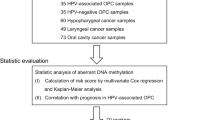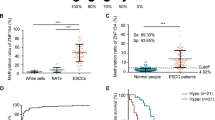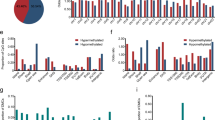Abstract
Identification of tumor suppressor genes (TSG) silenced by methylation uncovers mechanisms of tumorigenesis and identifies new epigenetic tumor markers for early cancer detection. Both nasopharyngeal carcinoma (NPC) and esophageal carcinoma are major tumors in Southern China and Southeast Asia. Through expression subtraction of NPC, we identified Deleted in Liver Cancer 1 (DLC1)/ARHGAP7 (NM_006094) – an 8p22 TSG as a major downregulated gene. Although expressed in all normal tissues, DLC1 was silenced or downregulated in 11/12 (91%) NPC, 6/15 (40%) esophageal, 5/8 (63%) cervical and 3/9 (33%) breast carcinoma cell lines. No genetic deletion of DLC1 was detected in NPC although a hemizygous deletion at 8p22–11 was found by 1-Mb array-CGH in some cell lines. We then located the functional DLC1 promoter by 5′-RACE and promoter activity assays. This promoter was frequently methylated in all downregulated cell lines and in a large collection of primary tumors including 89% (64/72) NPC (endemic and sporadic types), 51% (48/94) esophageal, 87% (7/8) cervical and 36% (5/14) breast carcinomas, but seldom in paired surgical marginal tissues and not in any normal epithelial tissue. The transcriptional silencing of DLC1 could be reversed by 5-aza-2′-deoxycytidine or genetic double knock-out of DNMT1 and DNMT3B. Furthermore, ectopic expression of DLC1 in NPC and esophageal carcinoma cells strongly inhibited their colony formation. We thus found frequent epigenetic silencing of DLC1 in NPC, esophageal and cervical carcinomas, and a high correlation of methylation with its downregulation, suggesting a predominant role of epigenetic inactivation. DLC1 appears to be a major TSG implicated in the pathogenesis of these tumors, and should be further tested as a molecular biomarker in patients with these cancers.
This is a preview of subscription content, access via your institution
Access options
Subscribe to this journal
Receive 50 print issues and online access
$259.00 per year
only $5.18 per issue
Buy this article
- Purchase on Springer Link
- Instant access to full article PDF
Prices may be subject to local taxes which are calculated during checkout





Similar content being viewed by others
References
Busson P, Ganem G, Flores P, Mugneret F, Clausse B, Caillou B et al. (1988). Establishment and characterization of three transplantable EBV-containing nasopharyngeal carcinomas. Int J Cancer 42: 599–606.
Chen YJ, Ko JY, Chen PJ, Shu CH, Hsu MT, Tsai SF et al. (1999). Chromosomal aberrations in nasopharyngeal carcinoma analyzed by comparative genomic hybridization. Genes Chromosomes Cancer 25: 169–175.
Cheng Y, Chakrabarti R, Garcia-Barcelo M, Ha TJ, Srivatsan ES, Stanbridge EJ et al. (2002). Mapping of nasopharyngeal carcinoma tumor-suppressive activity to a 1.8-megabase region of chromosome band 11q13. Genes Chromosomes Cancer 34: 97–103.
Cheng Y, Poulos NE, Lung ML, Hampton G, Ou B, Lerman MI et al. (1998). Functional evidence for a nasopharyngeal carcinoma tumor suppressor gene that maps at chromosome 3p21.3. Proc Natl Acad Sci USA 95: 3042–3047.
Deng W, Tsao SW, Guan XY, Lucas JN, Si HX, Leung CS et al. (2004). Distinct profiles of critically short telomeres are a key determinant of different chromosome aberrations in immortalized human cells: whole-genome evidence from multiple cell lines. Oncogene 23: 9090–9101.
Effert P, McCoy R, Abdel-Hamid M, Flynn K, Zhang Q, Busson P et al. (1992). Alterations of the p53 gene in nasopharyngeal carcinoma. J Virol 66: 3768–3775.
Etienne-Manneville S, Hall A . (2002). Rho GTPases in cell biology. Nature 420: 629–635.
Feng BJ, Huang W, Shugart YY, Lee MK, Zhang F, Xia JC et al. (2002). Genome-wide scan for familial nasopharyngeal carcinoma reveals evidence of linkage to chromosome 4. Nat Genet 31: 395–399.
Gardiner-Garden M, Frommer M . (1987). CpG islands in vertebrate genomes. J Mol Biol 196: 261–282.
Glaser R, Zhang HY, Yao KT, Zhu HC, Wang FX, Li GY et al. (1989). Two epithelial tumor cell lines (HNE-1 and HONE-1) latently infected with Epstein-Barr virus that were derived from nasopharyngeal carcinomas. Proc Natl Acad Sci USA 86: 9524–9528.
Gulley ML, Nicholls JM, Schneider BG, Amin MB, Ro JY, Geradts J . (1998). Nasopharyngeal carcinomas frequently lack the p16/MTS1 tumor suppressor protein but consistently express the retinoblastoma gene product. Am J Pathol 152: 865–869.
Hildesheim A, Levine PH . (1993). Etiology of nasopharyngeal carcinoma: a review. Epidemiol Rev 15: 466–485.
Homma Y, Emori Y . (1995). A dual functional signal mediator showing RhoGAP and phospholipase C-delta stimulating activities. EMBO J 14: 286–291.
Hui AB, Lo KW, Kwong J, Lam EC, Chan SY, Chow LS et al. (2003). Epigenetic inactivation of TSLC1 gene in nasopharyngeal carcinoma. Mol Carcinog 38: 170–178.
Hurst CD, Fiegler H, Carr P, Williams S, Carter NP, Knowles MA . (2004). High-resolution analysis of genomic copy number alterations in bladder cancer by microarray-based comparative genomic hybridization. Oncogene 23: 2250–2263.
Kim TM, Jeong HJ, Seo MY, Kim SC, Cho G, Park CH et al. (2005). Determination of genes related to gastrointestinal tract origin cancer cells using a cDNA microarray. Clin Cancer Res 11: 79–86.
Kim TY, Jong HS, Song SH, Dimtchev A, Jeong SJ, Lee JW et al. (2003). Transcriptional silencing of the DLC-1 tumor suppressor gene by epigenetic mechanism in gastric cancer cells. Oncogene 22: 3943–3951.
Lo KW, Huang DP, Lau KM . (1995). p16 gene alterations in nasopharyngeal carcinoma. Cancer Res 55: 2039–2043.
Lo KW, Teo PM, Hui AB, To KF, Tsang YS, Chan SY et al. (2000). High resolution allelotype of microdissected primary nasopharyngeal carcinoma. Cancer Res 60: 3348–3353.
Lu SJ, Day NE, Degos L, Lepage V, Wang PC, Chan SH et al. (1990). Linkage of a nasopharyngeal carcinoma susceptibility locus to the HLA region. Nature 346: 470–471.
Moon SY, Zheng Y . (2003). Rho GTPase-activating proteins in cell regulation. Trends Cell Biol 13: 13–22.
Murray PG, Qiu GH, Fu L, Waites ER, Srivastava G, Heys D et al. (2004). Frequent epigenetic inactivation of the RASSF1A tumor suppressor gene in Hodgkin's lymphoma. Oncogene 23: 1326–1331.
Pathmanathan R, Prasad U, Sadler R, Flynn K, Raab-Traub N . (1995). Clonal proliferations of cells infected with Epstein-Barr virus in preinvasive lesions related to nasopharyngeal carcinoma. N Engl J Med 333: 693–698.
Plaumann M, Seitz S, Frege R, Estevez-Schwarz L, Scherneck S . (2003). Analysis of DLC-1 expression in human breast cancer. J Cancer Res Clin Oncol 129: 349–354.
Qiu GH, Tan LK, Loh KS, Lim CY, Srivastava G, Tsai ST et al. (2004). The candidate tumor suppressor gene BLU, located at the commonly deleted region 3p21.3, is an E2F-regulated, stress-responsive gene and inactivated by both epigenetic and genetic mechanisms in nasopharyngeal carcinoma. Oncogene 23: 4793–4806.
Raab-Traub N . (2002). Epstein-Barr virus in the pathogenesis of NPC. Semin Cancer Biol 12: 431–441.
Rhee I, Bachman KE, Park BH, Jair KW, Yen RW, Schuebel KE et al. (2002). DNMT1 and DNMT3b cooperate to silence genes in human cancer cells. Nature 416: 552–556.
Sahai E, Olson MF, Marshall CJ . (2001). Cross-talk between Ras and Rho signalling pathways in transformation favours proliferation and increased motility. EMBO J 20: 755–766.
Spruck III CH, Tsai YC, Huang DP, Yang AS, Rideout III WM, Gonzalez-Zulueta M et al. (1992). Absence of p53 gene mutations in primary nasopharyngeal carcinomas. Cancer Res 52: 4787–4790.
Srivastava G, Wong KY, Chiang AK, Lam KY, Tao Q . (2000). Coinfection of multiple strains of Epstein-Barr virus in immunocompetent normal individuals: reassessment of the viral carrier state. Blood 95: 2443–2445.
Steenbergen RD, Kramer D, Braakhuis BJ, Stern PL, Verheijen RH, Meijer CJ et al. (2004). TSLC1 gene silencing in cervical cancer cell lines and cervical neoplasia. J Natl Cancer Inst 96: 294–305.
Steenbergen RD, Walboomers JM, Meijer CJ, van der Raaij-Helmer EM, Parker JN, Chow LT et al. (1996). Transition of human papillomavirus type 16 and 18 transfected human foreskin keratinocytes towards immortality: activation of telomerase and allele losses at 3p, 10p, 11q and/or 18q. Oncogene 13: 1249–1257.
Sun Y, Hegamyer G, Cheng YJ, Hildesheim A, Chen JY, Chen IH et al. (1992). An infrequent point mutation of the p53 gene in human nasopharyngeal carcinoma. Proc Natl Acad Sci USA 89: 6516–6520.
Tang JC, Wan TS, Wong N, Pang E, Lam KY, Law SY et al. (2001). Establishment and characterization of a new xenograft-derived human esophageal squamous cell carcinoma cell line SLMT-1 of Chinese origin. Cancer Genet Cytogenet 124: 36–41.
Tao Q, Huang H, Geiman TM, Lim CY, Fu L, Qiu GH et al. (2002). Defective de novo methylation of viral and cellular DNA sequences in ICF syndrome cells. Hum Mol Genet 11: 2091–2102.
Tao Q, Robertson KD, Manns A, Hildesheim A, Ambinder RF . (1998). The Epstein-Barr virus major latent promoter Qp is constitutively active, hypomethylated, and methylation sensitive. J Virol 72: 7075–7083.
Tao Q, Swinnen LJ, Yang J, Srivastava G, Robertson KD, Ambinder RF . (1999). Methylation status of the Epstein-Barr virus major latent promoter C in iatrogenic B cell lymphoproliferative disease. Application of PCR-based analysis. Am J Pathol 155: 619–625.
Tao Q, Young LS, Woodman CB, Murray PG . (2006). Epstein-Barr virus (EBV) and its associated human cancers – Genetics, epigenetics, pathobiology and novel therapeutics. Front Biosci 11: 2672–2713.
Teramoto A, Tsukuda K, Yano M, Toyooka S, Dote H, Doihara H et al. (2004). Less frequent promoter hypermethylation of DLC-1 gene in primary breast cancers. Oncol Rep 12: 141–144.
Tsao SW, Wang X, Liu Y, Cheung YC, Feng H, Zheng Z et al. (2002). Establishment of two immortalized nasopharyngeal epithelial cell lines using SV40 large T and HPV16E6/E7 viral oncogenes. Biochim Biophys Acta 1590: 150–158.
Wang DZ, Nur-E-Kamal MS, Tikoo A, Montague W, Maruta H . (1997). The GTPase and Rho GAP domains of p190, a tumor suppressor protein that binds the M(r) 120,000 Ras GAP, independently function as anti-Ras tumor suppressors. Cancer Res 57: 2478–2484.
Wilson PJ, McGlinn E, Marsh A, Evans T, Arnold J, Wright K et al. (2000). Sequence variants of DLC1 in colorectal and ovarian tumours. Hum Mutat 15: 156–165.
Wong CM, Lee JM, Ching YP, Jin DY, Ng IO . (2003). Genetic and epigenetic alterations of DLC-1 gene in hepatocellular carcinoma. Cancer Res 63: 7646–7651.
Wong ML, Tao Q, Fu L, Wong KY, Qiu GH, Law FB et al. (2006). Aberrant promoter hypermethylation and silencing of the critical 3p21 tumour suppressor gene, RASSF1A, in Chinese oesophageal squamous cell carcinoma. Int J Oncol 28: 767–773.
Xiong W, Zeng ZY, Xia JH, Xia K, Shen SR, Li XL et al. (2004). A susceptibility locus at chromosome 3p21 linked to familial nasopharyngeal carcinoma. Cancer Res 64: 1972–1974.
Ying J, Li H, Seng TJ, Langford C, Srivastava G, Tsao SW et al. (2006). Functional epigenetics identifies a protocadherin PCDH10 as a candidate tumor suppressor for nasopharyngeal, esophageal and multiple other carcinomas with frequent methylation. Oncogene 25: 1070–1080.
Ying J, Srivastava G, Hsieh WS, Gao Z, Murray P, Liao SK et al. (2005). The stress-responsive gene GADD45G is a functional tumor suppressor, with its response to environmental stresses frequently disrupted epigenetically in multiple tumors. Clin Cancer Res 11: 6442–6449.
Yu MC, Yuan JM . (2002). Epidemiology of nasopharyngeal carcinoma. Semin Cancer Biol 12: 421–429.
Yuan BZ, Durkin ME, Popescu NC . (2003a). Promoter hypermethylation of DLC-1, a candidate tumor suppressor gene, in several common human cancers. Cancer Genet Cytogenet 140: 113–117.
Yuan BZ, Jefferson AM, Baldwin KT, Thorgeirsson SS, Popescu NC, Reynolds SH . (2004). DLC-1 operates as a tumor suppressor gene in human non-small cell lung carcinomas. Oncogene 23: 1405–1411.
Yuan BZ, Miller MJ, Keck CL, Zimonjic DB, Thorgeirsson SS, Popescu NC . (1998). Cloning, characterization, and chromosomal localization of a gene frequently deleted in human liver cancer (DLC-1) homologous to rat RhoGAP. Cancer Res 58: 2196–2199.
Yuan BZ, Zhou X, Durkin ME, Zimonjic DB, Gumundsdottir K, Eyfjord JE et al. (2003b). DLC-1 gene inhibits human breast cancer cell growth and in vivo tumorigenicity. Oncogene 22: 445–450.
Zhou L, Jiang W, Ren C, Yin Z, Feng X, Liu W et al. (2005). Frequent Hypermethylation of RASSF1A and TSLC1, and High Viral Load of Epstein-Barr Virus DNA in Nasopharyngeal Carcinoma and Matched Tumor-Adjacent Tissues. Neoplasia 7: 809–815.
Acknowledgements
We thank Drs Bert Vogelstein, George Tsao, Dolly Huang, Kaitai Yao, Soh-ha Chan, Yixin Zeng, Ya Cao, Guiyuan Li, Shuen-Kuei Liao and Peter Stern for some cell lines, Cordelia Langford for the high-resolution (1-Mb) array-CGH slides, and Nicholas C Popescu for the DLC1 plasmid. This project was supported by an A*STAR grant (Johns Hopkins Singapore) and a Michael Kadoorie Cancer Genetics Research Fund grant (QT). Richard Ambinder is supported by an NIH grant (P01CA15396).
Author information
Authors and Affiliations
Corresponding author
Rights and permissions
About this article
Cite this article
Seng, T., Low, J., Li, H. et al. The major 8p22 tumor suppressor DLC1 is frequently silenced by methylation in both endemic and sporadic nasopharyngeal, esophageal, and cervical carcinomas, and inhibits tumor cell colony formation. Oncogene 26, 934–944 (2007). https://doi.org/10.1038/sj.onc.1209839
Received:
Revised:
Accepted:
Published:
Issue Date:
DOI: https://doi.org/10.1038/sj.onc.1209839
Keywords
This article is cited by
-
ARHGAP6 inhibits bladder cancer cell viability, migration, and invasion via β-catenin signaling and enhances mitomycin C sensitivity
Human Cell (2023)
-
LINC00114 stimulates growth and glycolysis of esophageal cancer cells by recruiting EZH2 to enhance H3K27me3 of DLC1
Clinical Epigenetics (2022)
-
Curcumin inhibits growth of human breast cancer cells through demethylation of DLC1 promoter
Molecular and Cellular Biochemistry (2017)
-
Epigenetic impact of infection on carcinogenesis: mechanisms and applications
Genome Medicine (2016)
-
DLC1 expression is reduced in human cutaneous melanoma and correlates with patient survival
Modern Pathology (2014)



